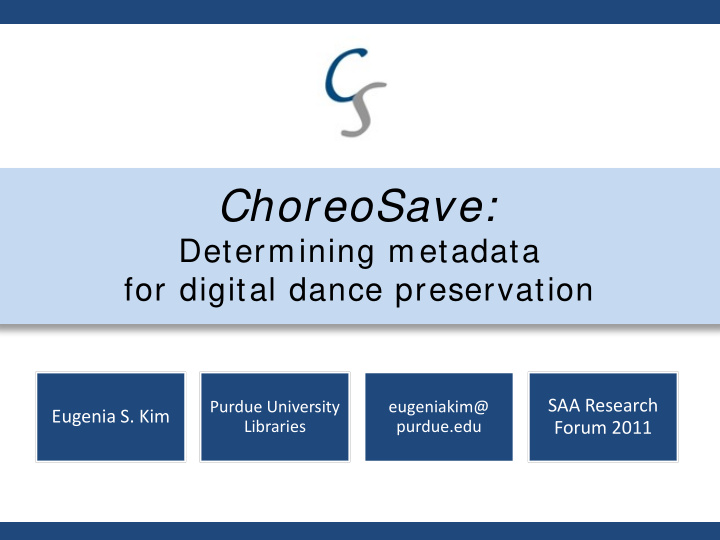



ChoreoSave: Determining metadata for digital dance preservation SAA Research Purdue University eugeniakim@ Eugenia S. Kim Libraries purdue.edu Forum 2011
What is… ? Digital Dance Preservation Dance Working definition: “…it is impossible to define…” - Curt Sachs, musicologist, 1937 “The use of digital technology to • Dance is ephemeral, multi- record essential choreographic faceted, and difficult to information for the recreation duplicate perfectly and reference of a dance work” • Choreography is not the same as Performance Different organizations have • different terms and definitions Dance Preservation • ‘Digital dance preservation’ is • Historic problem, many not the same as digitization solutions, no standard
So what is a ‘dance work’? Working Definition “ The overall collection of components related to a piece of choreography regardless of whether it was completed or made public”
The Primary Issue Problem Statement What are the necessary descriptive metadata elements to preserve a dance work in a digital repository? Solution: ChoreoSave A short-term preservation service for emerging choreographers who are not established artists affiliated with a major arts foundation. Implementation • Open source software, cloud computing , open access • Inspired by social media video-sharing website interfaces • Peer-produced : community contributes content, shapes service to its needs, not the administrators • Data curation : dance work as data set
Past Practices More Recent Developments Traditional Methods • Passing knowledge through • Preserve, Inc. (Leslie Hansen Kopp) generations Dance Heritage Coalition • • Documentation Focus on Access, Documentation, Preservation, Education – Notation (Labanotation, http://www.danceheritage.org/ Benesh Movement • Merce Cunningham ‘capsule’ Notation, etc.) http://www.merce.org/p/ – Print materials dance-capsules.php – Motion capture • Siobhan Davies RePlay (Sarah – Film and video Whatley) http://www.siobhandaviesreplay.com/
System Design Influences Merce Cunningham Capsules Siobhan Davies Replay • Siobhan Davies choreography • Merce Cunningham ‘capsule’ includes • “…the UK’s first digital dance archive” (2007) “…performance videos, sound recordings, lighting plots, décor • Interactive online website images, costume design, • Metadata elements include: production notes from rehearsal and performance, and interviews – Title, Date, Choreographer, with dancers and artistic staff Music, Design, Garments, (Cunningham Dance Foundation, Lighting, Dance Artists, 2009, p. 2).” Musician, Summary, and Analysis
Preliminary Data Collection About the Organizations Common Trends • Major non-profit institutions, • Required items: dance companies, and libraries – printed materials – photographs • 13 were contacted, 7 responded – films and videos • All from the United States, mainly • Ideal items: based in East Coast, one Midwest – Notations and scores location – Any materials relevant to • Have an archivist, librarian, or choreographer other information professional on – Any materials related to the use staff and preservation of the choreography • Surveyed June-July, 2010 • Other items
Preliminary Data Collection TABLE I: Types of items for archiving dance choreography Percentage of Total Percentage of Total Name of Item Frequency Responses Respondents Holistic Approach 1 4% 14% Music Scores and Media 1 4% 14% Dance Scores 2 9% 29% Lighting Cues and Designs 2 9% 29% Production Information 2 9% 29% Costume Sketches and 3 13% 43% Fabric Films/Videos 4 17% 57% Photographs 4 17% 57% Printed Materials 4 17% 57% i i i i h hi k li d b d
Proposed Metadata Schema Each element has a corresponding dance component • Lighting Designer(s), Crew • Title* Lighting Description and Notes • Movement Style • • Set Designer(s), Crew • Creation (Start) Date • Set Description and Notes • Official URL • Sound Designer(s), Crew • Related URLs • Sound Description and Notes • Choreographer(s)* Stage Crew (Stage Manager, etc.) • Description • • Photographer(s) • Choreography Notes • Videographer, Editor, etc. • Performers • Additional Technology Notes • Title of Music* • Live Performance Venues and Dates • Composer/Recording Artist Recorded Performance Venues and Dates • Musicians (for live and interactive • • Funders • performances) • Uncontrolled Keywords • Additional Details Regarding Music • Costume Designer(s), Staff * Indicates a required element
Metadata Entry Interface Starred items indicate a required element
Pilot Test Results Mixed Reactions Pilot Test - Most Essential Metadata Elements • Useful as tool (2) 4 • Would “eliminate many of the 3 Number of Responses fields.” (1) 2 Prototype might be “too much for a • casual choreographer.” (1) 1 User Feedback 0 Number of metadata elements Movement Music/ Song Description Number of Work Notes Style Performers Just enough metadata elements: 3 Too many metadata elements: 1 User Feedback on Number, Utility, and Utility of metadata elements Essentialness of Proposed Metadata Elements Elements are useful: 1 Elements are somewhat useful: 3
Future Development • Collaboration with Purdue University • Customized prototype • Apply principles of data curation and related services to dance – Dance work as ‘data set’ – Data Curation Profile – How does this research apply to digital humanities as a whole?
Recommend